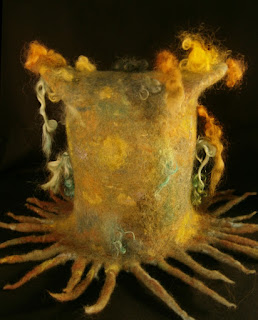Last time I did a World of Wool order, I got some 'Pencil Roving waste', it's a the bottom of this page here. I very recently learnt to knit and it is really nice to knit with. I was going through my commercial yarns recently, they're pretty much all tassley, eyelash, loopy things for embellishing felt, but right when I first discovered felting, I bought some thick and thin acrylic 'fake' pencil roving :
I've needlefelted and wet felted with it, and made a tiny knitted square when I first learnt and thought it would be perfect to use with the pencil roving to make something thick and soft and texturey. I used a multicoloured ball, and added in the pencil roving lengths as the previous one ran out. I think it's about 10 inches square:
I did neaten the ends a bit, and poke them through to one side, so this is the back:
I think the texture is really nice:
It got me thinking about making my own pencil roving, I kind of made some a while back when I was having my kitchen done, I spun some Merino on a drop spindle then knitted it straight from there a day or two later, but the drafting is such a pain from wool tops. Then I remembered Ann did a video right when we first started the Felting and Fiber Studio site about drafting roving using a diz. So, I blended a drum full of browns and turquoise/spearminty colours, found a button with a big hole and made myself some roving. I was impressed with myself, it only went thin a few times:
A few shorter lengths:
I thought this could be useful for making wet felting kits because I noticed people who've never seen wool tops before find them hard to pull off, and hand carded/drafted roving is much looser. I made a short video of the next lot I drafted. I made a new diz from a film tub lid, because I wanted it a bit wider and also made a little 'tool' from bent wire to help pull the wool through the hole.
Eco printing fun sharing 植物印染製作分享
6 days ago














































